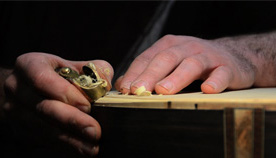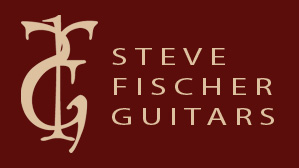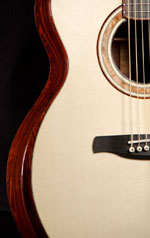The Difference
Hybrid X-Fan bracing
When I started designing guitars my ultimate goal was to create the best sounding guitar possible and create a sound that was unique to my guitars. In order to do get unique tone I would have to have a unique way of building guitars.
While studying the work of Torres I knew that I wanted to somehow achieve the beautiful rich bass and crisp treble that came from his guitars. That is when the idea came to me to replace the standard parallel tone bars usually found in the lower bout of the top with the fan bracing from a classical guitar. I would like to say I invented this but hybrid x-fan bracing has actually been around for a long time in one form or another. What I am using is a variation on the design I made for PRS. My new design uses more and thinner fan braces to liven up the response while also adding strength to key areas of the top.
Why Fan braces?
I use fan braces behind the bridge because this design works in better harmony with the physics of the guitar.
The strings are trying to pull the bridge forward toward the nut. This causes a twisting action at the bridge, pulling up on the top behind the bridge and pushing down in front of the bridge. While the traditional X brace is ideal to
counter act the force in front of the bridge the parallel tone bars don’t counter act the upward pull behind the
bridge in the most efficient way. By using fan braces I can directly counteract the string pull and more effectively
distribute the tension across the lower bout while making the braces much smaller and lighter. All of which
combines to allow the top to vibrate in the most natural and efficient way producing rich dynamic tone.
My Mission
Is to create instruments that allow the musician to create music without restriction, to create instruments that inspire the musician to create music above and beyond what they thought possible.
If I have done my job right the guitar will disappear in the hands of the player. What I mean by this is that the music will be able to flow freely without obstruction, without the musician ever having to say, "if only this guitar had a little more of this or that" or, "if only this guitar were easier to play." If the guitar gets in the way of the music, I have failed. If the player sits down and plays and loses all track of time and space and just plays music, then I have succeeded. If the tone of the instrument inspires musicians to create, then I have achieved my mission.
The Craftsman
What you are looking at is the culmination of ten years as a professional guitar maker. From my beginning education at Bryan Galloupís school of lutherie where I was introduced to the art of guitar making and seeing for the first time the potential of what a guitar can be; to my time building guitars for McPherson where I honed my attention to detail in every stage of the building process; to my time designing the acoustic line of guitars for PRS where I got to really consider every part of the guitar down to the last detail; to now where I am very pleased to launch Steve Fischer Guitars. I feel I am now building the finest instruments I have ever made, both in tone as well as the aesthetic beauty of the guitar. My hope is that my guitars will inspire musicians to make the music they have always wanted to make, and that you will enjoy playing the guitars as much as I enjoy making them.
first time the potential of what a guitar can be; to my time building guitars for McPherson where I honed my attention to detail in every stage of the building process; to my time designing the acoustic line of guitars for PRS where I got to really consider every part of the guitar down to the last detail; to now where I am very pleased to launch Steve Fischer Guitars. I feel I am now building the finest instruments I have ever made, both in tone as well as the aesthetic beauty of the guitar. My hope is that my guitars will inspire musicians to make the music they have always wanted to make, and that you will enjoy playing the guitars as much as I enjoy making them.


